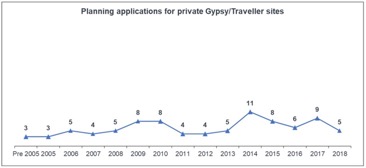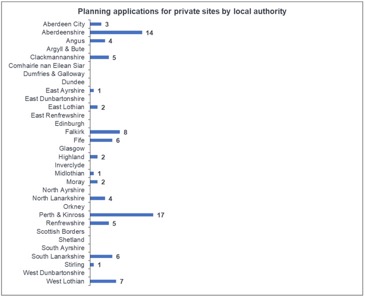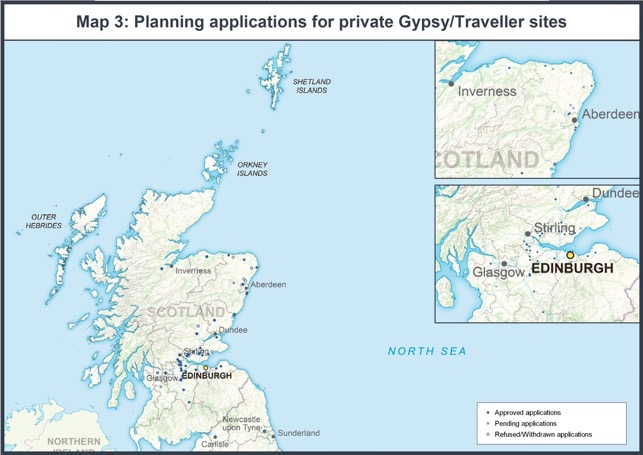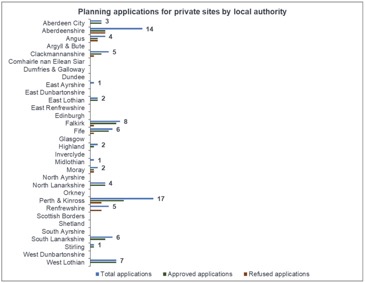Gypsy/Traveller Sites in Scotland
The report presents findings from a study collating data on Gypsy/Traveller sites in Scotland.
5 Planning applications for private Gypsy/Traveller sites
5.1 This section provides an overview of planning applications for private Gypsy/Traveller sites across Scotland over the last 10-15 years. Findings are based on information published via e-planning, cross-referenced with local authority records to maximise coverage of Gypsy/Traveller-related planning applications.
Overview of planning application activity
5.2 The study has identified a total of 88 planning applications for private Gypsy/Traveller sites across Scotland. This includes applications over the period 1992 to 2018, although the great majority are from 2005 to 2018 (85 of 88).[9] Over this period local authorities received an average of 6 planning applications for Gypsy/Traveller sites per year. While application numbers have fluctuated from year to year, there does not appear to have been a consistent upward or downward trend over the period.
Figure 12: Planning applications for private Gypsy/Traveller sites time series

5.3 Seventeen local authorities record one or more planning applications for Gypsy/Traveller sites; the remaining 15 local authority areas do not record any applications.[10] Most authorities have received a relatively small number of planning applications for Gypsy/Traveller sites, with 11 authorities reporting 5 or fewer applications. However, a small number of authorities report larger numbers of applications, most notably Aberdeenshire (14 applications) and Perth & Kinross
(17 applications) which together account for more than a third of all applications received. It is notable that these are both largely rural authority areas, and mapping of planning applications for Gypsy/Traveller sites indicates that the great majority are in areas classified as ‘accessible rural’ or ‘remote rural’.[11] As noted later, the rural profile of proposed sites is also reflected in some of the reasons for planning applications being refused, and the conditions applied where applications are approved.
Figure 13: Planning applications for private Gypsy/Traveller sites by local authority area

5.4 Available information indicates that most applications are for relatively small Gypsy/Traveller sites. Around two thirds of applications (57 of the 85 for which information is available) are for sites of fewer than five pitches, including 14 applications for single pitch sites. However, several applications are recorded for larger sites;
9 applications propose sites of ten or more pitches, including 2 for sites of more than
20 pitches. Consistent with the geographic distribution of other proposals, all applications for larger sites are in areas classified as ‘accessible rural’ or ‘remote rural’, although 4 of the 9 applications for larger sites are adjacent to small towns or urban areas.
5.5 Planning records include a range of detail on applications for private Gypsy/Traveller sites, but do not provide information that can support quantitative analysis of the profile of proposals (other than the location and size information presented above). Published records do indicate that sites typically comprise a relatively small number of pitches, each with space for chalet and touring caravans, vehicle parking, and an amenity block. However, proposals are also diverse in terms of the number of pitches to be provided (as noted above), the associated infrastructure requirements, landscaping proposals, and other facilities to be provided on site.
5.6 Below we provide an outline of several applications to illustrate this profile. These include a mix of smaller and larger sites, proposals approved at the initial application stage, approved on appeal, and refused applications.
Planning application: approved
Application date: March 2012
Decision date: October 2013
Appeal decision date: N/A
Proposal for the formation of 5 permanent Gypsy/Traveller pitches in an accessible rural area, on a former waste disposal site adjoining agricultural land. Proposed pitch layout included space for a chalet-type unit, up to 2 touring caravans and an amenity block to each pitch. The proposed site also included provision for a horse paddock.
A total of 44 representations were received to the applications, the great majority objecting to proposals.
The application was approved at the initial application stage, subject to conditions relating to approval of plans for waste and surface water drainage, provision of water supply, adequate vehicular access and parking, restrictions on noise generation, and approval of landscaping plans.
Planning application: refused
Application date: March 2010
Decision date: March 2011
Appeal decision date: August 2011
Proposal for formation of 6 permanent Gypsy/Traveller pitches in an accessible rural area. Proposed pitch layout included space for a chalet-type unit, up to 2 touring caravans, an amenity block to each pitch, and parking for 3 vehicles. The site plan also included stables adjacent to one pitch.
A total of 10 representations were received to the applications, all objecting to proposals.
The application was refused at the initial application stage. Reasoning included reference to the proposal being contrary to LDP policy relating to development in areas designated as ‘countryside around towns’, and the adverse visual impact within a countryside area.
An appeal was refused on the basis that the adverse impact on the rural environment outweighed the potential benefits of additional accommodation provision.
Planning application: approved on appeal
Application date: April 2010
Decision date: March 2011
Appeal decision date: January 2012
A proposal for change of use of disused agricultural land to form 5 permanent Gypsy/Traveller pitches in an accessible small town. Proposed pitch layout included space for a chalet-type unit, up to 2 touring caravans, an amenity block and parking for 3 vehicles.
A total of 280 representations were received to the planning applications, the great majority objecting to the proposal.
The application was refused at the initial application stage. Reasoning included reference to proposals being contrary to LDP policies regarding development in an area designated as of ‘landscape significance’ and ‘undeveloped coast’, and to proposals constituting inappropriate development in a rural area.
An appeal of the initial decision was successful, with planning permission granted subject to several conditions. These included conditions of local authority approval of materials used in the external finish, approval of a detailed landscaping plan, and limiting the hours of commercial deliveries and operation.
Planning application: approved on appeal
Application date: October 2014
Decision date: February 2016
Appeal decision date: November 2016
Proposal for change of use of agricultural land to form 4 permanent Gypsy/Traveller pitches in an accessible rural area adjacent to an urban area. The site had previously been used as an agricultural steading. Proposed pitch layout included space for a chalet-type unit, up to 2 touring caravans and an amenity block to each pitch. The proposal also included provision for storage of commercial vehicles and materials within a designated area.
A total of 45 representations were received to the applications, the great majority objecting to proposals.
The application was refused at the initial application stage. Reasoning included reference to business use being contrary to policies for the countryside location, and to the potential for proposals to generate additional pedestrian crossing of the public road. Published reports also indicate that the retrospective nature of the application was a factor in the decision to refuse permission.
An appeal of the initial decision was successful, with planning permission granted subject to conditions. These included conditions that each pitch is occupied by a single Gypsy/Traveller household, and conditions relating to access, lighting and landscaping, and to ensure the main use of the site remains for residential caravan accommodation.
Outcome of planning applications
5.7 Of the 88 planning applications recorded, 35 (40%) were approved at the initial application stage. A total of 34 applications (39%) were refused at the application stage – we provide an overview of the reasons recorded for refusal of these applications later in this section. The remaining applications included 6 where a decision is still pending (7%), 1 called in by Scottish Ministers, and 12 withdrawn (14%).
Figure 14: Outcome at initial planning application stage
| Total |
Approved |
Pending |
Refused |
Called in |
Withdrawn |
|
|---|---|---|---|---|---|---|
| SCOTLAND |
88 |
35 (40%) |
6 (7%) |
34 (39%) |
1 (1%) |
12 (14%) |
| Aberdeen City |
3 |
1 |
0 |
2 |
0 |
0 |
| Aberdeenshire |
14 |
2 |
0 |
6 |
1 |
5 |
| Angus |
4 |
1 |
0 |
3 |
0 |
0 |
| Argyll & Bute |
0 |
0 |
0 |
0 |
0 |
0 |
| Clackmannanshire |
5 |
2 |
0 |
2 |
0 |
1 |
| Comhairle nan Eilean Siar |
0 |
0 |
0 |
0 |
0 |
0 |
| Dumfries & Galloway |
0 |
0 |
0 |
0 |
0 |
0 |
| Dundee |
0 |
0 |
0 |
0 |
0 |
0 |
| East Ayrshire |
1 |
0 |
1 |
0 |
0 |
0 |
| East Dunbartonshire |
0 |
0 |
0 |
0 |
0 |
0 |
| East Lothian |
2 |
1 |
0 |
1 |
0 |
0 |
| East Renfrewshire |
0 |
0 |
0 |
0 |
0 |
0 |
| Edinburgh |
0 |
0 |
0 |
0 |
0 |
0 |
| Falkirk |
8 |
4 |
0 |
4 |
0 |
0 |
| Fife |
6 |
5 |
0 |
1 |
0 |
0 |
| Glasgow |
0 |
0 |
0 |
0 |
0 |
0 |
| Highland |
2 |
1 |
0 |
0 |
0 |
1 |
| Inverclyde |
0 |
0 |
0 |
0 |
0 |
0 |
| Midlothian |
1 |
0 |
0 |
0 |
0 |
1 |
| Moray |
2 |
0 |
0 |
2 |
0 |
0 |
| North Ayrshire |
0 |
0 |
0 |
0 |
0 |
0 |
| North Lanarkshire |
4 |
3 |
0 |
1 |
0 |
0 |
| Orkney |
0 |
0 |
0 |
0 |
0 |
0 |
| Perth & Kinross |
17 |
5 |
2 |
7 |
0 |
3 |
| Renfrewshire |
5 |
0 |
2 |
3 |
0 |
0 |
| Scottish Borders |
0 |
0 |
0 |
0 |
0 |
0 |
| Shetland |
0 |
0 |
0 |
0 |
0 |
0 |
| South Ayrshire |
0 |
0 |
0 |
0 |
0 |
0 |
| South Lanarkshire |
6 |
4 |
1 |
0 |
0 |
1 |
| Stirling |
1 |
0 |
0 |
1 |
0 |
0 |
| West Dunbartonshire |
0 |
0 |
0 |
0 |
0 |
0 |
| West Lothian |
7 |
6 |
0 |
1 |
0 |
0 |
5.8 Of the 34 cases refused at the application stage, 29 proceeded to appeal; this represents 85% of refused applications and 33% of all applications recorded. The majority of applications going to appeal were approved, 18 cases equating to 62% of appeals (and 53% of cases refused at the application stage). In the remaining 11 appeals the initial refusal decision was upheld.
Figure 15: Appeals of refused applications
| Total applications |
Appeals (% of applications) |
Approved (% of appeals) |
|
|---|---|---|---|
| SCOTLAND |
88 |
29 (33%) |
18 (62%) |
| Aberdeen City |
3 |
2 |
2 |
| Aberdeenshire |
14 |
5 |
2 |
| Angus |
4 |
3 |
1 |
| Argyll & Bute |
0 |
0 |
0 |
| Clackmannanshire |
5 |
2 |
1 |
| Comhairle nan Eilean Siar |
0 |
0 |
0 |
| Dumfries & Galloway |
0 |
0 |
0 |
| Dundee |
0 |
0 |
0 |
| East Ayrshire |
1 |
0 |
0 |
| East Dunbartonshire |
0 |
0 |
0 |
| East Lothian |
2 |
1 |
1 |
| East Renfrewshire |
0 |
0 |
0 |
| Edinburgh |
0 |
0 |
0 |
| Falkirk |
8 |
4 |
3 |
| Fife |
6 |
0 |
0 |
| Glasgow |
0 |
0 |
0 |
| Highland |
2 |
0 |
0 |
| Inverclyde |
0 |
0 |
0 |
| Midlothian* |
1 |
0 |
0 |
| Moray |
2 |
2 |
1 |
| North Ayrshire |
0 |
0 |
0 |
| North Lanarkshire |
4 |
1 |
1 |
| Orkney |
0 |
0 |
0 |
| Perth & Kinross |
17 |
4 |
4 |
| Renfrewshire |
5 |
3 |
0 |
| Scottish Borders |
0 |
0 |
0 |
| Shetland |
0 |
0 |
0 |
| South Ayrshire |
0 |
0 |
0 |
| South Lanarkshire |
6 |
0 |
0 |
| Stirling |
1 |
1 |
1 |
| West Dunbartonshire |
0 |
0 |
0 |
| West Lothian |
7 |
1 |
1 |
5.9 Map 3 shows locations that have been the subject of planning applications for private Gypsy/Traveller sites in Scotland, identifying applications approved at the application stage or on appeal, applications where a decision is pending, and applications that have been refused or withdrawn.

Approved planning applications
5.10 The 53 approved planning applications for Gypsy/Traveller sites represent 60% of all applications recorded. These include 35 approved at the initial application stage, and 18 approved on appeal after being refused at initial application. Approved applications propose to provide a total of more than 200 private site pitches, equivalent to an average of around 4 pitches per site although proposals range from single pitch to 16 pitch sites.
5.11 The study considered information provided by authorities on conditions applied to these approved planning applications. Decision notices are not published in all cases, but information on planning conditions was available for 43 of the 53 approved applications.
5.12 These cases indicate that conditions most commonly relate to restrictions on site occupancy and use, landscaping of sites and screening to mitigate visual impact, foul and surface water drainage, and vehicular access arrangements:
- Site occupancy and use. In 34 of 43 cases, planning permission was granted with conditions relating to site occupancy and use. These conditions most commonly specified that the site is used only by Gypsy/Traveller households; this condition was applied to 22 approved applications, including 11 where conditions required that the site is used only by the applicant and their family. In addition, in 20 cases conditions were applied limiting the number of caravans on site at any one time, and/or limiting the length of time that ancillary caravans or units can be occupied. In terms of site use, 9 approvals specified that sites were for residential use only, and 5 placed limits on business activity and/or storage of scrap or commercial materials on site.
- Landscaping and screening of sites was specified as a condition for 31 of 43 approved applications. This was most commonly requiring local authority approval of a detailed site landscaping plan and planting scheme, although in several cases conditions were set relating to site boundaries and screening to mitigate visual impact.
- Foul and surface water drainage was referenced in conditions for 18 of 43 approved applications. This typically required applicants to submit a detailed drainage plan for approval, although in 6 cases conditions also placed specific requirements in relation to the water supply and/or sewage treatment.
- Vehicular access arrangements and parking. Conditions relating to access and parking were applied to 17 of 43 approved applications. This included requirements that access arrangements are approved by authorities, requirements for the upgrade of access, and provision of parking arrangements and turning spaces.
- Other conditions were applied to 21 of 43 approved applications, and related to varying aspects of approved proposals. This included 12 cases requiring approval of refuse storage arrangements, 4 requiring approval of development materials, finish and/or colour scheme, 4 requiring assessment and remediation of any contamination, 4 requiring approval of external lighting, and 3 referring to compliance with noise regulations.
Figure 16: Determination of planning applications
| Total applications received |
Initial applications approved |
Approved on appeal |
Refused, withdrawn or pending |
|
|---|---|---|---|---|
| SCOTLAND |
88 |
35 (40%) |
18 (20%) |
35 (40%) |
| Aberdeen City |
3 |
1 |
2 |
0 |
| Aberdeenshire |
14 |
2 |
2 |
10 |
| Angus |
4 |
1 |
1 |
2 |
| Argyll & Bute |
0 |
0 |
0 |
0 |
| Clackmannanshire |
5 |
2 |
1 |
2 |
| Comhairle nan Eilean Siar |
0 |
0 |
0 |
0 |
| Dumfries & Galloway |
0 |
0 |
0 |
0 |
| Dundee |
0 |
0 |
0 |
0 |
| East Ayrshire |
1 |
0 |
0 |
1 |
| East Dunbartonshire |
0 |
0 |
0 |
0 |
| East Lothian |
2 |
1 |
1 |
0 |
| East Renfrewshire |
0 |
0 |
0 |
0 |
| Edinburgh |
0 |
0 |
0 |
0 |
| Falkirk |
8 |
4 |
3 |
1 |
| Fife |
6 |
5 |
0 |
1 |
| Glasgow |
0 |
0 |
0 |
0 |
| Highland |
2 |
1 |
0 |
1 |
| Inverclyde |
0 |
0 |
0 |
0 |
| Midlothian* |
1 |
0 |
0 |
1 |
| Moray |
2 |
0 |
1 |
1 |
| North Ayrshire |
0 |
0 |
0 |
0 |
| North Lanarkshire |
4 |
3 |
1 |
0 |
| Orkney |
0 |
0 |
0 |
0 |
| Perth & Kinross |
17 |
5 |
4 |
8 |
| Renfrewshire |
5 |
0 |
0 |
5 |
| Scottish Borders |
0 |
0 |
0 |
0 |
| Shetland |
0 |
0 |
0 |
0 |
| South Ayrshire |
0 |
0 |
0 |
0 |
| South Lanarkshire |
6 |
4 |
0 |
2 |
| Stirling |
1 |
0 |
1 |
0 |
| West Dunbartonshire |
0 |
0 |
0 |
0 |
| West Lothian |
7 |
6 |
1 |
0 |
Figure 17: Determined planning applications

Refused planning applications
5.13 As noted earlier, 34 planning applications for Gypsy/Traveller sites were refused at the application stage, with 16 of these refusals remaining unchallenged by the applicant, being upheld at appeal or subject to an as-yet-unresolved appeal. Refused applications were broadly similar to all applications in terms of their proposed size, although all were for sites providing fewer than 10 pitches.
5.14 The study considered the reasoning provided by planning authorities for refused applications to provide further detail on the range of factors contributing to refusal of planning permission for these cases. Decision notices are not published for all refused applications, but information on reasons for refusal was available for 28 of the 34 private site applications refused at the application stage (with 5 of these cases including further decision notices related to refused appeals).
5.15 Published decision notices indicate that reasons for refusal most commonly relate to proposals being contrary to the Local Development Plan and Strategic Development Plan policies. This included some which noted that material considerations in favour of proposals (most commonly an identified need for Gypsy/Traveller accommodation) were insufficient to outweigh these points. LDP and SDP policies were cited as a key reason for refusal for 20 of the 28 applications for which information is available, most frequently with reference to proposals having an adverse impact on the character of the area. This included reference to adverse impact on countryside settings and failing to meet policy criteria for development of agricultural land, but also to designation of landscape value such as Sites of Special Scientific Interest, ‘areas of landscape significance’, ‘undeveloped coast’ or ‘countryside around towns’. Other reference to LDP and SDP policies included proposals being contrary to countryside development policies, to applicants having failed to demonstrate a need for additional Gypsy/Traveller provision, to a proposed business use being contrary to policies on the countryside location, and one case where development of Gypsy/Traveller sites is not permitted within established residential areas.
5.16 Decision notices also highlight a range of other reasons for refusal of planning permission for Gypsy/Traveller sites. These are summarised below.
- Impact on local character was cited as a reason for 17 of 28 refusals. This was most commonly in relation to the impact of proposals on the local natural environment (14 of the 17 cases), and primarily the potential negative visual impact in countryside areas. Several of these reasonings noted that insufficient landscaping or planting had been proposed to mitigate the visual impact of development. A number of notices also made reference to potential detrimental impact on the amenity enjoyed by neighbouring residents (7 cases). This included reference to the proximity of proposed sites to established communities, and the extent to which proposals would integrate with the local built environment.
- Infrastructure and access to amenities. Six applications were refused with reference to their impact on local infrastructure and facilities, and potential for development to lead to increased car use and/or more pedestrians (including a small number noting that Gypsy/Traveller sites could require more use of larger or commercial vehicles). This included reference to inadequate or substandard local road infrastructure and/or site access, poor access to public transport, and limited pedestrian routes.
- Drainage and flooding. Five applications were refused due to inadequate or unclear proposals for drainage and water connections. This included 3 where reference was made to the proposed site being at substantial risk of fluvial flooding.
- Other reasons for refusal. These included reference to applicants having failed to demonstrate a need for additional Gypsy/Traveller provision, to insufficient clarity regarding site layout and use, to potentially adverse environmental impact (including risk of water contamination), to waste having been already deposited on the proposed site, and to the applicant failing to demonstrate that the site had been permanently used as a Gypsy/Traveller pitch for a 10 year period prior to submission of the planning application.
Contact
Email: Chief.Planner@gov.scot
There is a problem
Thanks for your feedback